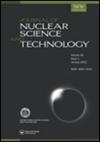基于紧凑D-D中子发生器的辐射生物装置设计研究
IF 1.7
4区 工程技术
Q2 NUCLEAR SCIENCE & TECHNOLOGY
引用次数: 0
摘要
在本研究中,我们采用自行研制的紧凑型D-D中子发生器,设计了一个中子辐射生物装置。研究结果表明,铅是中子渗透率最好的材料;因此,我们选择硬铅作为该装置的结构材料。我们的研究揭示了一个与传统观点不同的现象,即从设备顶部的硬铅材料反射的中子的剂量贡献大约是聚乙烯材料的两倍。因此,本装置顶部反射镜的材料也选用了硬铅。研究还表明,该装置具有良好的剂量均匀性,根据模拟结果可以得到各照射区的标准中子吸收剂量。该装置可进一步促进中子辐射生物效应和突变育种等未来研究工作的发展。关键词:D-D中子发生器中子辐射生物装置吸收剂量免责声明作为对作者和研究人员的服务,我们提供此版本的已接受稿件(AM)。在最终出版版本记录(VoR)之前,将对该手稿进行编辑、排版和审查。在制作和印前,可能会发现可能影响内容的错误,所有适用于期刊的法律免责声明也与这些版本有关。国家自然科学基金项目(No. 12075106)、甘肃省自然科学基金项目(No. 20JR10RA607)和中央高校基本科研业务费专项资助。披露声明作者未报告潜在的利益冲突。本研究由中央高校基本科研业务费资助;国家自然科学基金[12075106];甘肃省自然科学基金项目[20JR10RA607]。本文章由计算机程序翻译,如有差异,请以英文原文为准。
Research on the design of a radiation biodevice based on a compact D-D neutron generator
ABSTRACTIn this research, we used a self-developed compact D-D neutron generator and designed a neutron radiation biological device. The research results showed that lead was the material with the best neutron permeability; thus, hard lead was selected as the structural material for this device. Our research disclosed a phenomenon that differed from conventional wisdom, namely, the dose contribution of the neutrons reflected from the hard lead material at the top of the device was about twice that of the polyethylene material. Therefore, hard lead was also selected for the material of the top reflector in this device. The study also showed that the device had good dose uniformity, and the standard neutron absorption dose in each irradiation zone could be obtained according to the simulation results. This device may further promote the development of future research work such as neutron radiation biological effects and mutation breeding.KEYWORDS: D-D neutron generatorNeutronRadiation biodeviceAbsorption doseDisclaimerAs a service to authors and researchers we are providing this version of an accepted manuscript (AM). Copyediting, typesetting, and review of the resulting proofs will be undertaken on this manuscript before final publication of the Version of Record (VoR). During production and pre-press, errors may be discovered which could affect the content, and all legal disclaimers that apply to the journal relate to these versions also. AcknowledgementsThis work was Supported by the National Natural Science Foundation of China (No. 12075106), the Natural Science Foundation of Gansu Province (No. 20JR10RA607), and the Fundamental Research Funds for the Central Universities of China.Disclosure statementNo potential conflict of interest was reported by the author(s).Additional informationFundingThis work was supported by the Fundamental Research Funds for the Central Universities; National Natural Science Foundation of China [12075106]; Natural Science Foundation of Gansu Province [20JR10RA607].
求助全文
通过发布文献求助,成功后即可免费获取论文全文。
去求助
来源期刊

Journal of Nuclear Science and Technology
工程技术-核科学技术
CiteScore
2.40
自引率
16.70%
发文量
116
审稿时长
2.3 months
期刊介绍:
The Journal of Nuclear Science and Technology (JNST) publishes internationally peer-reviewed papers that contribute to the exchange of research, ideas and developments in the field of nuclear science and technology, to contribute peaceful and sustainable development of the World.
JNST ’s broad scope covers a wide range of topics within its subject category, including but are not limited to:
General Issues related to Nuclear Power Utilization: Philosophy and Ethics, Justice and Policy, International Relation, Economical and Sociological Aspects, Environmental Aspects, Education, Documentation and Database, Nuclear Non-Proliferation, Safeguard
Radiation, Accelerator and Beam Technologies: Nuclear Physics, Nuclear Reaction for Engineering, Nuclear Data Measurement and Evaluation, Integral Verification/Validation and Benchmark on Nuclear Data, Radiation Behaviors and Shielding, Radiation Physics, Radiation Detection and Measurement, Accelerator and Beam Technology, Synchrotron Radiation, Medical Reactor and Accelerator, Neutron Source, Neutron Technology
Nuclear Reactor Physics: Reactor Physics Experiments, Reactor Neutronics Design and Evaluation, Reactor Analysis, Neutron Transport Calculation, Reactor Dynamics Experiment, Nuclear Criticality Safety, Fuel Burnup and Nuclear Transmutation,
Reactor Instrumentation and Control, Human-Machine System: Reactor Instrumentation and Control System, Human Factor, Control Room and Operator Interface Design, Remote Control, Robotics, Image Processing
Thermal Hydraulics: Thermal Hydraulic Experiment and Analysis, Thermal Hydraulic Design, Thermal Hydraulics of Single/Two/Multi Phase Flow, Interactive Phenomena with Fluid, Measurement Technology...etc.
 求助内容:
求助内容: 应助结果提醒方式:
应助结果提醒方式:


